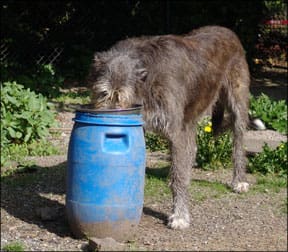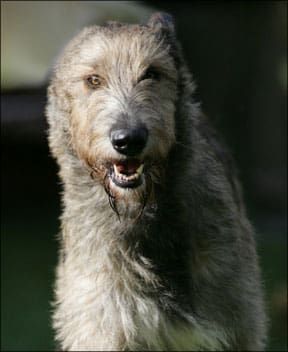Eeeewww! What’s that awful smell?
If your dog thinks it’s the most exciting thing you’ve ever put in a bowl while you gag and hold your breath, it’s probably green tripe – raw, unprocessed stomach tissue from ruminants such as cows or sheep. Tripe fans claim that this smelly meat has multiple benefits for dogs who are lucky enough to have it regularly fed to them.
Mary Voss knows the fragrance well. Twenty years ago, she and her husband, Peter, lived in the Netherlands, where they bought their first dog, an Afghan Hound.
“All the old-time breeders there fed their dogs green tripe,” she says. “It was sold in stores and was easy to find, so that’s what we fed our dog, too.”
But after moving back to the United States, she found that the only tripe sold in markets was white honeycomb tripe that had been bleached, scalded, and deodorized. Her growing canine family did without until local butchers put her in touch with farm slaughterers who agreed to sell her tripe fresh from the cattle.

“The first time I brought a cow’s stomachs straight from a farm,” she says, “it was a hot day, the drive was over 100 miles, and the container in the back of my truck stank to high heaven. When I finally got home, the dogs went berserk. They couldn’t see the truck, but they were so excited by the smell they were screaming.”
From that day on, Voss kept her dogs supplied with fresh tripe, which is called “green” even though it’s really brown, because the tripe of grass-fed cattle has a greenish tint. The terms “green tripe” and “dirty tripe” refer to the raw, unprocessed meat (not the contents) of a ruminant’s stomachs.
In 1997, Voss wrote “No Guts, No Glory,” an article about green tripe, for the Afghan Hound Review. In it she described how her dogs, who were already on a well-balanced raw diet, experienced immediate improvements in coat, skin, energy, teeth, and digestion when they switched to a diet comprised mostly of green tripe. One of her rescues, a 12-year-old whose teeth were so terrible that she had trouble eating and who was so weak that she could barely walk across the backyard, thrived on tripe and lived to be 17. “She could still run with the pack, discipline the ‘young and restless,’ and had the most beautiful set of white teeth without ever having a dental cleaning.”
For a while, Voss collected stomachs from farm-slaughtered cows and cut up the huge (60- to 100-pound) organs herself, wearing rubber boots, rubber gloves, and a heavy duty butcher’s apron while wielding a hose, two buckets, and a large, sharp knife. For convenience, she eventually started a co-op that distributed raw frozen tripe from other sources to dog lovers. However, quality was always a concern, so five years ago, she opened her own small factory in Hollister, California. “We started in a 1,000 square-foot building,” she says. “Now we’re in a 6,000 square-foot building. The word has definitely gotten out.” Every week, Voss ships 8,000 to 10,000 pounds of frozen, raw, green tripe from pasture-fed cattle to dog lovers across the country.
Thanks to industrial equipment, the work of turning cow stomachs into ground, frozen green tripe is now easier, but most of us would still consider it daunting. In June, Mike Rowe, host of the Discovery Channel’s program “Dirty Jobs,” visited Voss’s facility for an episode that will be broadcast this fall.
It’s international
Tripe may be an unfamiliar dog food in the United States, but not in other parts of the world.
Gerry Briffa, who has supplied raw meat for zoos and pets since 1960, has met and spoken with breeders in Europe, South Africa, Australia, and around the globe who swear by green tripe.
“They all say the same thing,” he says, “that it keeps the dogs healthy, is easy to digest, and it helps dogs live longer.”
Katrina McQuilken was raised in Russia, where she says everyone fed raw tripe to their dogs. At the Ridgewood, New Jersey, pet health food store that she runs with her husband, Karl, McQuilken finds that demand for tripe is increasing. “We have always carried raw meat dinners for dogs,” she says, “but now we need extra freezer space for all the green tripe that customers order. Customers who grew up in Poland, Hungary, Germany, and other countries in Europe tell me that this is what their dogs at home ate.”
Knocknarea Irish Wolfhounds, near Sligo, Ireland, is owned by Ika Peiler and her husband, Ulli, who have raised Irish Wolfhounds for more than 25 years. “Once a week,” Ika says, “Ulli goes directly to the source, a medium-sized slaughterhouse. The meat is for the local market, so the animals are all young heifers under 24 months. We also collect the stomachs of lambs.
As the complete digestive system is removed in one piece, Ulli Peiler first separates the tripe section from the intestines, liver, and spleen. He trims off excess fat before opening and emptying the stomachs, turning them inside out and rinsing them, which he does not for hygienic reasons but because sand and soil that animals pick up while grazing cling to their stomach linings.
Once home, the bellies are chilled for a few hours, then sent through an industrial meat grinder. For years the Peilers cut tripe into fist-sized pieces, but that was such hard work that they invested in grinding equipment. Red meat and hearts are ground separately. Liver, which is not suitable for grinding, is cut into pieces. The week’s supply is refrigerated, with any surplus frozen in bags.

“We fed nothing but tripe to our own dogs in the early years,” says Ika, “but we encountered fertility problems. Our bitches would not conceive. We read two studies that a veterinary student in Germany conducted for his doctoral thesis and learned that tripe lacks the amino acid tyrosine, which is apparently needed to kick-start the pituitary gland and the process of conceiving.” Red meat contains tyrosine, and when the Peilers began adding it to their dogs’ tripe diets, healthy puppies soon followed.
Dogs who board with the Peilers eat only fresh raw tripe. “It’s convenient,” says Ika, “and the dogs eat it right away. More importantly, the dogs do exceptionally well on their all-tripe diet.
Note that feeding green tripe alone, as a sole ingredient in the diet, does not constitute a complete and balanced diet. Tripe is a terrific supplement, and may even be used as a major component of a home-prepared diet, but it is not nutritionally complete by itself.
The Peilers’ own dogs eat mostly tripe with occasional organ meats, red meat, and bones. Ika Peiler says, “They don’t need or crave anything else, except that pregnant bitches go off their tripe and prefer muscle or organ meat and meaty bones toward the end of gestation, and they dig into carbs after whelping. That is the only time we give carbohydrates, in the form of raw crushed oat flakes in milk. It is a great way to stimulate milk production, and the conversion from carbs to milk is much quicker than from fat to milk. Once their milk production is in full swing and there is a constant supply of food for the dam, she won’t want oats any more and we can cut them back.”
Tripe’s benefits
Reports from tripe enthusiasts make it sound as though green tripe can bring dead dogs back to life, and that’s not much of an exaggeration. Mary Voss began to appreciate tripe’s benefits when a friend involved in all-breed rescue asked her to help save a litter of infant Rottweiler puppies that had been abandoned in a carport in winter.
“There were nine in the litter,” she says, “and they split the pups among three of us. Our job was to bottle-feed and wean the pups, then bring them back at eight weeks for adoption.”
Voss started weaning her charges at four weeks and gradually added green tripe. “When we brought the pups back together again, the three I raised were bigger, stronger, and more robust,” she says. “Their coats glistened and their eyes were bright and alert. Most of all, their personalities were confident, fun-loving, and just good-natured. The other pups were smaller and sickly, their coats were dull, and they were not very alert. Their temperaments were also questionable because they seemed too shy to be Rotties.”
When asked to describe the benefits of feeding green tripe, the breeders and dog lovers we polled all mentioned improvements in health, appearance, and disposition. Puppies thrive while avoiding bone growth problems, older dogs become more lively and active, digestive disorders vanish or improve dramatically, skin problems disappear, coats shine, coat color improves, eyes brighten, muscles become toned, teeth look terrific, stool size diminishes, and endurance and stamina increase. Dogs with behavioral problems become calmer, some chronic illnesses or conditions improve or disappear, dogs with breeding problems successfully reproduce, pups raised on green tripe excel at everything, elderly dogs resume their careers and win competitions, and the list goes on.
Of course, not every dog will respond dramatically to green tripe, but enough have to make it seem like a cure-all.
Several analyses show that tripe’s calcium-phosphorus ratio is 1:1, which is considered ideal for dogs. Its overall pH is slightly acidic, which aids digestion. The protein content of raw tripe is 10 percent and its fat content is about 5 percent. Tripe contains the essential fatty acids (linoleic and linolenic) in their recommended proportions as well as magnesium, potassium, B-complex vitamins, the amino acid taurine, other amino acids, about 4 percent fiber, and trace amounts of other minerals and vitamins A, C, D, and E. Green tripe is approximately 78 percent water or moisture. The protein level of dehydrated tripe is about 21 percent.

“We were surprised to find that tripe contains large amounts of Lactobacillus acidophilus, the lactic acid bacteria that is the main ingredient in probiotics,” says Voss. “Green tripe is also loaded with gastric enzymes, other gastric “juices,” and amino acids. The same gastric juices that help cattle with digestion aid the canine in digesting and efficiently utilizing food, and the amino acids are necessary for muscular development. As a bonus, coarsely ground tripe works like dental floss and is one of the best cleaners for a dog’s teeth.
As with any dog food, the right amount depends on the dog’s age, metabolism, and activity level. Couch potatoes don’t need much, while dogs working in adverse conditions require thousands of calories per day.
In Orange County, New York, Jeanne Patterson lives with three Irish Wolfhounds, two 155-pound males and a 105-pound female. “I learned how to feed tripe from the Peilers when I got a puppy from them,” she says.
About two-thirds of Patterson’s dogs’ diet is raw green tripe, with the remainder an alternating assortment of raw red meat, heart, liver, whole chicken, and an occasional green vegetable. How much they eat depends on how active they are, which means less in summer and more in cool weather, usually three to four pounds per dog each day.
Patterson buys frozen ground tripe, which she thaws in cold water. “It’s almost as easy as feeding kibble,” she says. “I just put it in a bowl, and they love it.”
Patterson credits tripe for her dogs’ long lives. “I’ve had five Irish Wolfhounds,” she says, “and the first two lived to be nine and almost twelve. In the U.S., their average life span is six and a half years.”
Almost everyone we interviewed for this article mentioned that dogs fed green tripe tend to live longer, have fewer injuries and health problems, and have cleaner, whiter teeth than dogs fed other foods.
“Even if they don’t live forever,” says Voss, “they are more likely to have an active old age with fewer aches and pains than they otherwise would. My Afghan Hounds have lived to be as old as 18, and the five living with us now are going on 15 and 17. Green tripe has to be one of the easiest and least expensive health treatments we can offer our canine companions.”
Green tripe is exceptionally easy to feed because even finicky dogs dive right in. Tripe is the one food most dogs respond to even when they refuse everything else. It is also well tolerated by many dogs with allergies and food sensitivities. Some breeders and suppliers report that dogs who cannot eat beef do well on beef tripe, and many dogs with seasonal allergies and skin conditions like hot spots, lick granulomas, and rashes have improved after switching to tripe.
“What we find really amazing,” adds Ika Peiler, “is that our hounds do not lose interest in their food although it is the same day in and day out. They always get very animated come feeding time and cannot wait to get their dishes put in front of them. They usually empty their bowls in five seconds flat – and if they don’t, I know there’s something wrong.”
The fragrance
To call green tripe odoriferous is an understatement. This stuff really stinks.
Some dog lovers just hold their breath. Others say they get used to it or don’t notice it at all.
Katrina McQuilken recommends keeping tripe frozen until the last minute, then thawing it just enough to remove the desired amount, returning the package to the freezer while placing the still-frozen serving in a bowl.
Cold temperatures reduce tripe’s odor, and so does the speed with which dogs consume it. Once it’s in your dog’s stomach, it won’t be scenting the house.
Of course, if you have a fenced backyard or large porch, even better. Your dog can enjoy his favorite food while you breathe comfortably.
Trends in tripe
The newest tripe products include dried or freeze-dried tripe treats as well as fresh frozen tripe from animals other than cattle. Some distributors sell lamb, sheep, goat, venison, or bison tripe. Lamb tripe is far less odoriferous than beef tripe, and when freeze-dried, it makes an almost odorless treat that you can comfortably carry in your pocket. Dried tripe strips are perfect canine toothbrushes.
Some frozen food manufacturers mix green tripe with meat, organ meats, vegetables, or other ingredients for nutritional balance or variety. At GreenTripe.com, Inc., Mary Voss sells three basic products: coarsely ground green tripe, green tripe ground with collagen-rich trachea and gullet (the natural source of condroitin sulfate and recommended for dogs with hip and joint problems), and Xkaliber, a blend of green tripe, muscle meat, heart, tongue, trachea/gullet, and ground bone, which is recommended for young dogs and serious working dogs because it helps build muscle and stamina.
Another trend is for seriously motivated dog lovers to contact local butchers or pasture-fed farms and ranches in order to purchase whole cow stomachs straight from the farm. Check with local farmer’s markets, meat markets, and food co-ops.
One advantage of working with local suppliers is that they can sometimes prepare special orders. For example, dogs with kidney failure, kidney disease, or blocked kidneys should avoid the amino acids methionine and cysteine. The omasum, or third stomach, is extremely high in collagen and low in protein and its amino acids. Some suppliers set this tripe aside for dogs with special needs.
CJ Puotinen is a frequent WDJ contributor and freelance writer living in New York. She is also the author of The Encyclopedia of Natural Pet Care and many books on holistic health care and herbal remedies for humans.







Great article.
Great article. Just received my first shipment of tripe and x caliber from Mary Voss at greentripe.com. I’ve a 4 yr old female and 3 yr old male Rottweiler.
I’ve tried to provide the best kibble but never felt I was providing the best for the dogs .Never one to settle I ordered this product , dogs love it , and hopefully I’ve done everything for my dogs future nutritional needs .
Is Green tripe good for dogs with kidney disease/failure? If so, about what is the servings for an 9 year that is recovering from kidney failure?